We’ve made geodesic dome kits so that anyone and everyone can effortlessly build them for whatever purpose they’d like. Whether that’s a greenhouse for your allotment, an event space for your party, or a science project at school. We pride ourselves on the ease of construction and versatility of our product!
However, there are a number of geodesic domes worldwide, that unfortunately, cannot be constructed in your back garden within an hour, and may require a more advanced kit to build…
In this article, we’re going to take a look at some of the most famous geodesic domes around the world.
Eden Project (Cornwall, UK)
One incredibly popular attraction, especially in the UK, is the Eden Project, situated in South West England. It's hailed as the 'world's largest greenhouse and botanical garden.'
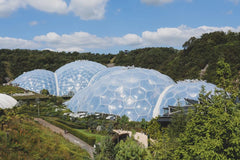
The Eden Project offers a wealth of experiences. Visitors can explore the expansive indoor rainforest, taking a journey through the humid tropics, which includes biomes from regions like SE Asia, West Africa, and South America.
The complex primarily features two interconnected enclosures, each resembling a natural biome and housing thousands of plant species. These enclosures are constructed using hundreds of inflated ETFE cells, supported by geodesic tubular steel domes.
For those looking for a Mediterranean experience, there's the Med Biome, where you can immerse yourself in the sights, scents, and stories of the Mediterranean, California, South Africa, and Western Australia. The Eden Project even offers zip lines and adventure activities, along with hosting the Eden Sessions summer music concerts, which aim to raise environmental awareness among concertgoers.
The project draws inspiration from James T. Baldwin's Pillow Dome and was conceptualised by Tim Smith and Jonathan Ball. The steel frame and thermoplastic structural system took 2 ½ years to complete before opening to the public in March 2001. Remarkably, the structure is entirely self-supporting, with no internal supports, and its panels vary in size, with the largest ones at the top of the structure.
Today, it welcomes tens of thousands of visitors annually and has even made appearances in popular culture, serving as a filming location for the 2002 James Bond film, Die Another Day.
If you’re looking for more information on the Eden Project visit their website here!
Spaceship Earth (Orlando, FL, USA)
Spaceship Earth is an iconic attraction at the Epcot theme park in Walt Disney World, Florida. Since the park's opening in 1982, this geodesic dome has proudly stood as the symbol of Epcot, affectionately known as the 'Epcot Ball.’
This immersive ride invites guests on a journey through time, themed around a time machine experience. It showcases how advancements in human communication have played a pivotal role in shaping our future, step by step. The dome itself boasts impressive dimensions, measuring 50 meters in diameter and soaring to a height of 55 meters. Its structural support comes from three pairs of sturdy legs, showcasing the visionary architectural design envisioned by the Wallace Floyd Design Group.
This geodesic dome continues to inspire and educate visitors about the transformative power of human communication, making it a must-see attraction for all who visit Walt Disney World.
Find out more about the EPCOT theme park here!
Biosphere of Montreal (Montreal, Quebec)
For the 1967 World's Fair Exposition in Montreal, the United States government enlisted the brilliant architect and scientist Buckminster Fuller to craft a pavilion that would represent the USA on the Canadian stage. Fuller, renowned for popularising and perfecting the Geodesic Dome, envisioned a colossal 20-story-tall dome, echoing his signature design.

This monumental steel structure became a focal point, attracting over 5.6 million visitors who ventured inside to explore exhibits showcasing actual spaceships from the Apollo missions and American artistry. Originally intended to be assembled using bolts for easy disassembly post-fair, budget constraints led to the decision to weld the dome's components together, firmly embedding the structure in Montreal's skyline.
For nearly nine years, the dome remained accessible to the public, until an unfortunate incident during routine welding maintenance led to a dramatic fire, engulfing the entire sphere for 30 minutes. When the flames finally receded, the acrylic walls had vanished, leaving behind the steel trusses of the dome.
In June 1995, the dome was repurposed as a museum dedicated to environmental advocacy. The dome faced another challenge in 1998 when an ice storm forced the Biosphere to close for five months. Despite the trials of fire and Canadian ice storms, the Montreal Biosphere endures as a testament to Buckminster Fuller's visionary geodesic architecture.
To visit their website, click here.
Buckminster Fuller’s own home (Illinois, USA)
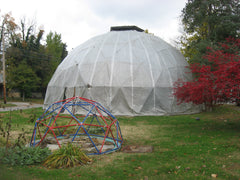
Forest Avenue in Carbondale, Illinois, is home to a remarkable geodesic dome house that served as the residence of Buckminster Fuller from 1960 to 1971.
Read more about him here.
La Geode (Paris, France)
La Geode, located in Parc de la Villette at the Cité des Sciences et de l’Industrie (City of Science and Industry) in the 19th arrondissement of Paris, France, is a mesmerising geodesic dome featuring an Omnimax theatre.
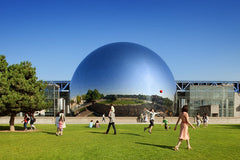
This architectural wonder was the collaborative creation of architect Adrien Fainsilber and engineer Gérard Chamayou. With a diameter of 36 metres, the geodesic dome is constructed from 6,433 polished stainless steel equilateral triangles, forming a reflective sphere that mirrors the sky. The dome is securely positioned on a reinforced concrete base, seamlessly integrated with the Cité des Sciences et de l’Industrie, which happens to be the largest science museum in Europe.
To visit their website, click here.
Telus Sphere (Vancouver, Canada)
Constructed from 1-mm thick extruded aluminium and aluminium panels with a combined weight of approximately 6,800 kg, this impressive geodesic dome, worth millions, was initially erected for the 1986 World’s Fair.

This renowned facility provides families with both enduring and rotating interactive and educational science displays, as well as captivating shows at the OMNIMAX theatre. It has rapidly evolved into a prominent city landmark and achieved the distinction of being voted as Vancouver's most iconic building in a Twitter poll.
Matrimandir at Auroville (Bommayapalayam, India)
The construction of Matrimandir, signifying "the dwelling place of Mother," spanned an extensive 37-year period, commencing in February 1971 and culminating in May 2008. Fortunately, the enduring effort invested in those decades has borne fruit, as countless yoga and meditation practitioners pilgrimage to this sanctuary seeking tranquillity and contemplation.
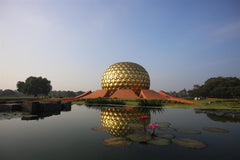
Matrimandir boasts a facade with golden discs, encircled by 12 graceful petals, and upheld by four pillars. The visionary behind this temple was Mirra Alfassa, also recognised as the Mother of Sri Aurobindo Ashram, who entrusted the French architect Roger Anger with crafting the design. The sunlight dances upon the golden discs around the structure, resembling a colossal golden egg nestled in the heart of the landscape - quite the easter egg hunt!
Want to find out more? Click here!
The Nature House in the Arctic Circle (Sandhornøya island, Norway)
The Glass Dome Eco House, affectionately named "The Nature House," serves as the residence for the Hjertefølger family, whose name aptly translates to "heart followers" in Norwegian. This led to the creation of this remarkable 25-foot-high geodome, spanning three stories and boasting five bedrooms, nestled on Norway's Sandhornøya island, situated approximately 1000 kilometres north of Oslo.

This unique house is cocooned within a sustainably constructed and eco-conscious dome, crafted from organic materials such as sand, water, and clay. These materials not only provide natural insulation by retaining heat but also form a protective shield, safeguarding the family from the capricious Arctic climate.
Within the dome is a thriving garden, growing an array of fruits and vegetables for the family's consumption. However, the pièce de résistance lies in the breathtaking panoramic vistas encircling the dome, granting the family unhindered access to the renowned Northern Lights—an experience akin to residing in an eco-friendly bubble. Quite the spot for a star gaze hey?
For more information, click here.
The Glass Dome in Dali Museum (Figueres, Spain)
The Dalí Theatre and Museum, a prominent attraction in Catalonia, Spain, already garners significant tourist attention due to its impressive collection of works by surrealist artist Salvador Dalí, along with the artist's final resting place in his hometown of Figueres. However, visitors are also captivated by the museum's remarkable geodesic glass dome, adorning the roof.
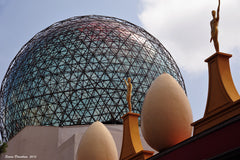
This Glass Dome serves as a brilliant source of illumination for the stage of the old theatre beneath, enhancing the viewing experience of Dalí's masterpieces. The ingenious geodome design was conceived by architect Emilio Pérez Piñero as a structural solution to preserve the theatre, which had suffered extensive damage during the conclusion of the Spanish Civil War.
To find out more, click here!
Climatron at the Missouri Botanical Garden (Missouri, USA)
This acclaimed geodome, a creation by St. Louis architects Murphy and Mackey, boasts an aluminium framework adorned with plexiglass panels. However, Climatron's initial plastic panels posed various issues, including leaks and discolouration. As a solution, heat-tempered glass panes replaced the problematic panels during a renovation. This alteration, although beneficial for durability, added considerable weight and stress to the dome's structure, necessitating the construction of a dome within the dome for reinforcement, think of it like Russian dolls.

Remarkably, this conservatory is recognised as the world's inaugural fully air-conditioned one, accommodating over 2,800 plants that thrive within its climate-controlled environment. The geodesic dome design optimises natural light and space, creating an ambience reminiscent of a lush tropical rainforest, thanks to its computerised climate control system.
To find out more, visit their website.
Pollution Pods - Michael Pinsky - international
We hope you don’t mind us sneaking one of our projects in here. We were really chuffed to help Michael Pinsky bring his idea to life, the five pollution pods were built using hubs kits! They’ve toured all around the world, from London to New York, to Geneva to Vancouver, really try to visit if you get a chance.
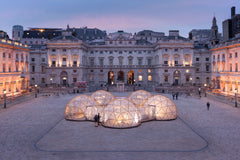
Pollution Pods are five interconnected geodesic domes that house meticulously crafted environments that replicate the atmospheric conditions found in London, Norway, New Delhi, San Paolo, and Beijing. Beginning at a coastal location in Norway, visitors traverse a progression of increasingly polluted cells, transitioning from arid and cold climates to hot and humid conditions.

The creation of Pollution Pods was commissioned by NTNU as a component of the Climart initiative, a four-year research project. This project delves into the fundamental psychological mechanisms that influence both the creation and reception of visual art, aiming to bridge the gap between natural sciences and the visual arts through its findings. We were really proud to be a part of this great project, if you’d like to find out more, visit their website!
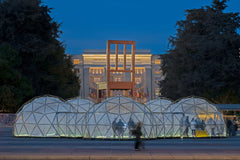
If you’d like to read more about our geodesic dome DIY kit then find our other blogs here, and if you’re interested in building your own dome, you can browse our shop here.
